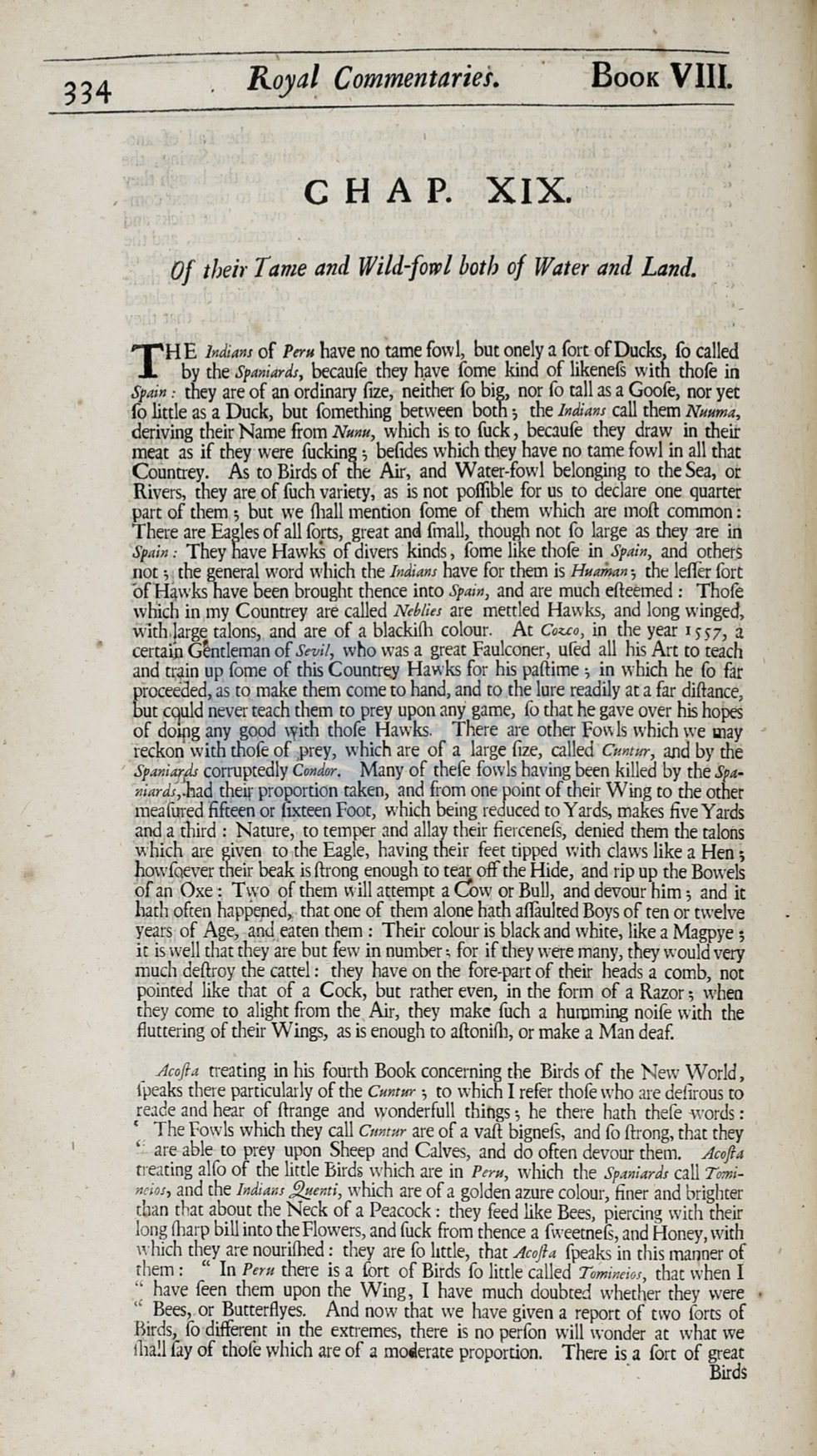

334
K~ya~
Commentar.iei.
BooK
VIII.
'/
;
'
CH A P.
XIX~
l
,,
l'
·o¡
the~r Tame and Wild-fowl both of Water and Land.
T
HE
Jndians
of
Peru
have no tame fow
1,
but onely a fort ofDucks
fo
called
by the·
Spaniard1,
becaufe they h,ave fome kind of likenef§ with chofe iri
Spain :
they are of an ordinary fize, neither
fo
big, nor fo tall as a Goofe, nor yec
fo
little as a Duck, but fomething between both ; che
lndian1
call them
Nuumá,
deriving their Name from
Nunu,
which is
to
fuck, becaufe they draw in theit
meat as if théy·were fucking; beíides which they have no tame fowl in all thac
Coiinérey.
As to Birds of the
Air,
and Water-fowl belonging to theSea, ot
Rivers, chey
are.offuch variety, as is not poffible for us to declare one quarter
pare of them ; but we íhall mention fome of them which are moíl: common :
There are Eagles of all fo¡cs, gt:eat a_n~ final!, thouih not fo _large
~
they are in
Spain:
They bave Hawks of divers kmds, fome hke chofe·m
Spam,
and ocher,s
not ;
1
che general word which the
Indians
have for them is
Huaman;
the leífer forc
ófHªwks have been brought thence into
Spain,
and are much eíl:eemed : Thofe
wh'iéh in my Coumrey are called
Neblie1
are mettled Hawks, and long winged,
with1Jarg~ talons,,and are of a blackiíh colour. Ac
Couo,
in th~ year
1557,
a
certai,p G!mleman of
Sevil,
who was a great Faulconer, uíed all h1s Are to teach
and cr.~in up fome of this Countr~y Hawks for his paíl:ime; in which he
fo
far
'
proceeded,.as
to
make them come to hand, a~d ro .the lure readily ac a far ~iílance,
bue cquld never reach them
to
prey upon any game, fo that he gave over hJS hopés
of dolflg any gopd vyjth chofe Hawks. There are other Fowls which we i;nay
,
feckon ·with chofe of ,Prey, which are of a large íize, called
Cuntur,
and by the
'
Spania¡fa
corruptedly
Condor.
Many of the[e fowls having been killed by che
Spa–
'niards,
:J,adtqei.r proportion taken, and from one point of their Wing to che other
1ñea'1i,
v.edtifteen or f~teen Foot, which being reduced
to
Yards, makes five Yards
aod,a iliird : 'Nature,.
to
temper and allay their fiercenefs, denied them che talons
which are given to ,the Eagle, having their feet tipped with claws like a Hen;
P,o'j'[Qever their beak is íl:rong_ enough
to
tear offche Hide, and rip up _che Bowels
ofan Oxe ·:. T\VO of them w1ll at;,tempt a Cow or Bull, and devour h1m ; and
it
ha~h o.fcen happeped,,. that one of them alone hath aífaulted Boys of tenor twelve
year~·of Age, -<1¡;_1<1,.eaten them : Their colour ~s black and white, like a Magpye;
ir is well thac they are bue few in number; for 1f they wére many, they would very
rnuch deílroy the cartel: -they have on che fore-parc of their heads a comb, not
pointed like chat of a Cock, bue rather even, in che form of a Razor ; wheo
chey come to alight from the,Air, they make füch a huruming noife wich che
fluttering of their Wings, as is enough to aíl:onifh, or make a Man deaf.
Acofta
treating in his fourch Book concerning the Birds of che
ew World,
{µeaks there parcicularly of che
Cuntur
;
to which
I
refer chofe who are defirous to
re:ide aod hear of flrange and 'l}'onderfull tbings ; he there hath chete -words :
' , The Fowls which they call
Ctmtur
are of a vaíl: bigoefs, aod fo íl:rong, thac they
' · are able to prey upon Sheep and Calves, and do often devour them.
Acofta
treating alto of che little Birds which are in
Peru,
which che
Spaniard1
call
Tomi–
neios,
and che
Indians ,fl.y,enti,
which are of a golden azure colour, finer and brighter
cban rbat ab_o~c the Neck of a Peacock: chey feed like Bees, piercing with thcir
Ion~ (harp b1ll meo t~e Flowers, and fuck from thence a fweetnefs, and Honey, with
wh1ch they are n0unfhed: they are fo httle, that
Acofta
fpeaks in chis manner of
tbem:
"
In
Peru
there is a Íbrt of Birds
fo
little called
Tomineios
thac when
!
" have feen them upon che Wing,
I
have much doubced whetl~er chey were
'' Bees
2
.or Bu~terflyes. And now that we have given a report of cwo forts of
Birds, fo-different in che extremes, there is no perfoo will v,:onder ac what we
íha!l fay of thofe which are of a mo.ierate proportion. There is a fort of great
. .
Birds














